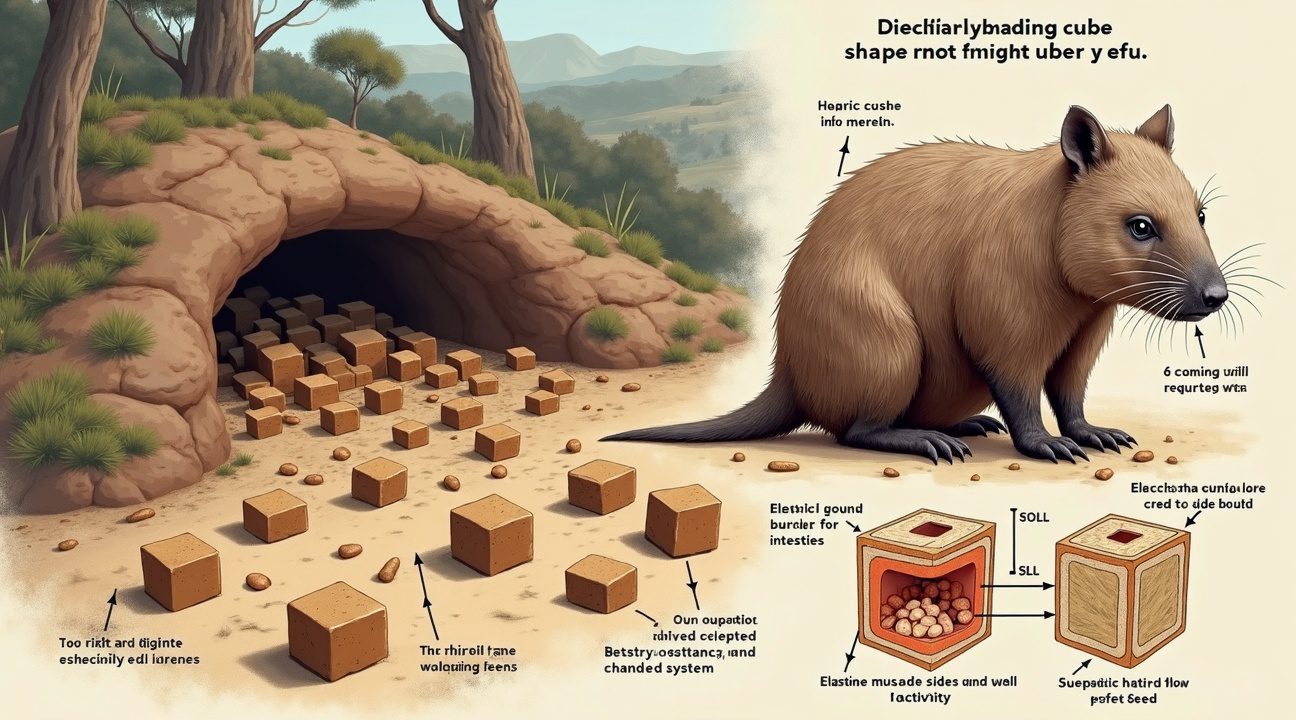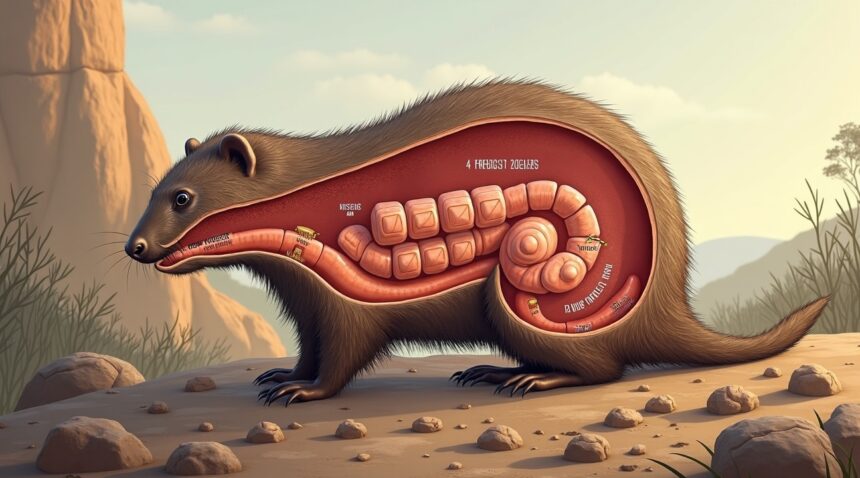Wombats create the only naturally occurring cube-shaped droppings in the animal kingdom, a fascinating result of unique physiological and evolutionary adaptations.
Key Takeaways
- Wombats are the only animals on Earth known to consistently produce cube-shaped droppings, with each wombat generating 80–100 cubes daily due to their specialized intestinal anatomy.
- The cubic formation takes place in the final 8–17% of the wombat’s 33-foot-long intestine, shaped by variations in wall stiffness and approximately 40,000 coordinated muscle contractions over a 14–18 day digestion process.
- These cube-shaped droppings act as effective territorial markers, resisting rolling on uneven terrain and thus aiding in long-lasting scent-based communication strategies.
- The unique biomechanical digestion process has inspired research in medical diagnostics and industrial design, influencing innovations in how materials are processed and shaped in constrained environments.
- Unlike other animals that produce round feces due to uniform intestinal contractions, wombats contain specialized digestive structures with rigid ridges and pressure zones that create this unusual geometry.
More on Scientific and Technological Implications
The study of this biological marvel has far-reaching implications. Researchers have used the wombat’s intestinal mechanics as a model for designing more efficient extrusion mechanisms in industrial manufacturing processes. Additionally, it offers valuable insights into the diagnosis of gastrointestinal motility disorders in humans.
This intersection of natural adaptation and modern science demonstrates how the evolutionary quirk of the wombat can help advance both our understanding of biology and the sustainability of engineered systems.
The Secret Behind Nature’s Most Unusual Bathroom Habit
Wombats hold the extraordinary distinction of being the only animals on Earth that produce cube-shaped feces. This remarkable biological phenomenon defies everything we typically understand about waste elimination in the animal kingdom. Each dropping displays six mostly flat sides with slightly rounded edges, creating a geometric shape that appears almost manufactured rather than naturally produced.
The sheer volume of these cubic creations is equally impressive. Bare-nosed wombats (Vombatus ursinus) can excrete between 80 to 100 of these distinctive cubes each day, with each individual piece measuring approximately 2 centimeters in width. This prolific output means a single wombat can produce hundreds of perfectly formed geometric droppings weekly, creating what amounts to nature’s most unusual construction project.
The Anatomical Engineering Behind Cubic Waste
This bizarre bathroom behavior stems directly from the wombat’s specialized digestive anatomy and processing methods. The marsupial’s intestines contain varying elasticity levels that create distinct pressure zones during the digestion process. Unlike other mammals whose intestinal walls maintain relatively uniform flexibility, wombats possess specific rigid and elastic sections that systematically mold their waste into cubes.
The digestive journey takes an exceptionally long time in wombats, sometimes lasting up to two weeks for complete processing. During this extended period, the intestinal walls gradually compress and shape the waste material through rhythmic contractions. The final portion of the digestive tract functions like a biological cube-forming machine, applying precise pressure patterns that create the characteristic flat surfaces and slightly rounded edges.
Several factors contribute to this unique shaping process:
- Extended digestion time allows for thorough dehydration and compression
- Specialized intestinal muscle patterns create uniform pressure distribution
- Varying wall elasticity in different intestinal sections forms distinct geometric angles
- Slow transit speed ensures complete cube formation before elimination
This anatomical adaptation serves multiple evolutionary purposes beyond mere curiosity. The cubic shape prevents the droppings from rolling away on slopes, which proves particularly valuable in the wombat’s rocky, hilly habitat. This stability allows wombats to use their waste for territorial marking more effectively than animals with traditional round droppings.
The precision of this biological engineering rivals human manufacturing processes. Each cube maintains remarkably consistent dimensions and angles, demonstrating the incredible efficiency of the wombat’s digestive system. Scientists continue studying this phenomenon to understand potential applications in industrial design and waste management systems.
While other animals might accidentally produce occasionally angular waste due to dietary factors or temporary digestive issues, only wombats consistently manufacture these geometric masterpieces. This consistency across the entire species indicates a deeply ingrained evolutionary adaptation rather than a random occurrence.
The discovery of this unique trait has fascinated researchers and nature enthusiasts alike, spawning numerous studies into digestive biomechanics. Understanding how wombats achieve this seemingly impossible feat could potentially inform human engineering projects and medical research into digestive disorders.
From practical observation, wildlife researchers have documented that fresh wombat cubes maintain their shape for extended periods in various weather conditions. This durability further emphasizes the sophisticated biological processes involved in their creation.
The cube-shaped droppings represent far more than an amusing quirk of nature. They showcase the incredible adaptability of mammalian digestive systems and demonstrate how evolutionary pressures can produce unexpected solutions to environmental challenges. Each perfectly formed cube stands as testament to millions of years of evolutionary refinement, creating a biological phenomenon that continues to puzzle and delight scientists studying digestive anatomy.
https://www.youtube.com/watch?v=71ZpZ8nVbyw

How Wombat Intestines Actually Create Perfect Cubes
The formation of cubic wombat droppings occurs entirely within the digestive tract, not at the anus or through external factors. This remarkable process unfolds in the final 8 to 17 percent of the wombat’s extraordinarily long 33-foot intestine, where specialized anatomy transforms ordinary waste into geometric perfection.
The Science Behind Intestinal Cube Formation
The secret lies in the non-uniform stiffness of the intestinal walls during the final stages of digestion. Different regions of the intestine possess varying degrees of thickness and flexibility, creating a natural molding system that shapes the feces into distinct cubes. Areas with greater stiffness contract more rapidly and forcefully, forming the sharp corners and edges that define each cube. Meanwhile, softer sections of the intestinal wall allow the flat surfaces to develop properly.
I find the rubber band analogy particularly helpful for understanding this process. Picture a rubber band stretched tight at both ends while sagging in the middle – this alternating pattern of tension and relaxation mirrors exactly what happens inside a wombat’s intestine. The varying pressure points create the systematic formation that results in those perfectly defined cubic shapes.
The Extended Digestion Timeline
The cube formation process requires an exceptionally slow digestive timeline. Food takes between 14 to 18 days to complete its journey through the wombat’s intestinal system. This extended timeframe allows for thorough extraction of water and nutrients, leaving behind remarkably dry and firm fecal matter that holds its cubic shape.
During this lengthy process, approximately 40,000 individual intestinal contractions occur. Each contraction contributes to defining the shape and accentuating the cube edges. The systematic nature of these contractions, combined with the varying intestinal wall properties, ensures consistent cube formation regardless of diet variations.
The round shape of the wombat’s anus plays no role in creating the cubic form, which surprises many people who assume the shape must form during the final exit. By the time the feces reach the anus, they’ve already been perfectly molded into their distinctive cubic form through the intricate intestinal process.
This unique digestive adaptation serves practical purposes for wombats in their natural habitat. The cubic shape prevents the droppings from rolling away on slopes, helping wombats mark their territory more effectively. Unlike other dangerous animals that might use scent marking differently, wombats rely on strategically placed cubic droppings to communicate with other wombats in their area.
The precision of this biological process demonstrates the incredible adaptability of digestive systems in response to environmental needs. Each cube represents thousands of coordinated muscular contractions working in perfect harmony with specialized intestinal anatomy. The result is a feat of biological engineering that produces the only naturally occurring cubic feces in the animal kingdom, making wombats truly unique among all species on Earth.

Why Other Animals Can’t Make Square Poop
The digestive systems of most mammals operate with remarkably uniform intestinal contractions that naturally produce round or tubular feces. When I examine typical mammalian anatomy, the smooth muscle walls of the intestines contract rhythmically and evenly, creating a consistent pressure that shapes waste into familiar cylindrical forms. This standard process occurs across countless species, from tiny rodents to massive elephants.
Wombats break this universal pattern through their extraordinary digestive architecture. Their intestines feature distinct grooves and regions of variable stiffness that fundamentally alter how waste moves and forms during digestion. These specialized anatomical adaptations create uneven pressure points that gradually mold the fecal matter into distinctive cubic shapes over the extended 14–18 day digestive process.
Scientific Evidence from Comparative Studies
Research teams have conducted fascinating experiments to understand why other animals can’t replicate wombat cube formation. Scientists inflated pig intestines to test their flexibility and expansion patterns, revealing crucial differences in digestive mechanics. The pig intestines expanded uniformly in all directions, lacking the specific groove patterns and variable stiffness zones found in wombat anatomy.
These experimental findings demonstrate several key points:
- Uniform intestinal expansion creates consistent pressure that produces round shapes
- Standard mammalian intestines lack the specialized ridges needed for angular formation
- Variable stiffness regions are essential for creating the flat surfaces and sharp corners of cubic feces
- The extended digestive timeline in wombats allows sufficient time for cube formation
The inability to replicate angular corners in laboratory conditions using other mammalian intestines confirms that cube-shaped feces requires the specific combination of anatomical features exclusive to wombats. Other animals simply don’t possess the necessary digestive infrastructure to overcome the natural tendency for uniform expansion and round waste formation.
This anatomical uniqueness explains why wombats remain the sole cube-producing species on Earth. Even closely related marsupials lack these specialized intestinal modifications, highlighting just how extraordinary this evolutionary adaptation truly is. The precision required for consistent cube formation demonstrates that this isn’t merely an accident of anatomy but rather a highly specialized biological process that has evolved specifically in wombats over millions of years.
The Genius Strategy Behind Cube-Shaped Droppings
Wombats don’t produce cubic feces by accident – this unique shape serves as an ingenious territorial marking system that maximizes communication effectiveness. The flat surfaces of these distinctive droppings prevent them from rolling away from strategic locations, creating permanent scent markers that announce a wombat’s presence to others in the area.
Territory marking becomes remarkably efficient when droppings stay exactly where wombats place them. These cube-shaped deposits remain stable on rocks, fallen logs, and elevated surfaces around burrow entrances, unlike the spherical droppings of other animals that tend to roll into hidden crevices or down slopes. This stability ensures that scent markers maintain their positions in high-visibility locations where other wombats will encounter them during their travels.
The strategic placement of cubic droppings helps prevent costly territorial disputes by clearly communicating boundaries. When wombats detect these scent markers, they can assess whether an area is already occupied and make informed decisions about where to forage or establish their own territories. This chemical communication system reduces the need for direct confrontations, which can result in injuries or waste valuable energy that’s better spent on finding food or mates.
Communication Benefits for Mating Success
Cubic droppings play a crucial role in wombat reproductive behavior by serving multiple communication functions:
- Enhanced scent retention due to increased surface area contact with the ground
- Improved visibility from greater distances compared to scattered round pellets
- Longer-lasting chemical signals that persist through weather changes
- Clear indication of the depositor’s size, health, and reproductive status
The stable nature of cube-shaped feces allows scent compounds to concentrate and linger much longer than traditional droppings would. This extended chemical presence gives potential mates more opportunities to detect and respond to reproductive signals, increasing the likelihood of successful breeding encounters. Female wombats can assess male fitness and territory quality through these persistent scent markers, while males can identify receptive females and optimal mating opportunities.
Much like how dangerous wildlife uses various strategies for survival, wombats have evolved this remarkable adaptation to thrive in their competitive environment. The cube shape also helps wombats avoid wasting energy on repeated marking of the same locations, since their droppings don’t migrate from their intended positions.
Scientists have observed that wombats typically deposit 80 to 100 cube-shaped pellets each night, strategically distributing them across their territory to create an effective communication network. This consistent marking pattern helps maintain social order within wombat populations and reduces stress-related conflicts that could impact overall health and survival rates.
The genius of cubic droppings extends beyond simple territory marking – it represents an evolutionary solution that addresses multiple survival challenges simultaneously. By ensuring their scent markers remain exactly where they’re placed, wombats have developed one of nature’s most efficient communication systems. This adaptation demonstrates how even the most unusual biological features often serve essential survival functions that benefit entire populations through improved social coordination and reproductive success.
https://www.youtube.com/watch?v=8objZhx7n5g
What Wombat Poop Teaches Us About Health and Innovation
I find it fascinating how wombat droppings serve as a window into both animal health monitoring and cutting-edge scientific applications. In captivity, veterinarians and researchers closely observe the consistency and shape of wombat feces as a diagnostic tool. When droppings deviate from their characteristic cubic form or show irregular consistency, these changes often signal potential gastrointestinal issues that require immediate attention.
The precise formation of cubic waste indicates a healthy digestive system functioning at optimal levels. Irregular shapes or soft textures can point to dietary imbalances, parasitic infections, or other digestive disorders. This natural health indicator proves invaluable for wildlife care professionals monitoring captive wombat populations.
Scientific Applications Beyond Animal Care
The biomechanical process behind cube formation has captured the attention of medical researchers and engineers worldwide. Scientists believe that understanding this unique digestive mechanism could revolutionize colon function evaluation methods. The way wombat intestines compress and shape waste material offers insights that might improve non-invasive diagnostic techniques for human digestive health.
Medical applications extend to cancer detection research, where the wombat’s intestinal mechanics could inspire new tools for early screening. The precise pressure variations and muscular contractions that create cubic shapes might inform the development of diagnostic equipment capable of detecting abnormal tissue formations or blockages with greater accuracy.
Engineers have also taken notice of this natural manufacturing process. The ability to transform soft, pliable material into perfectly geometric shapes without external molds or high-energy processes presents remarkable industrial possibilities. Manufacturing industries constantly seek energy-efficient methods for creating specific shapes from malleable materials, and the wombat’s digestive system offers a biological blueprint for such innovations.
Current research focuses on replicating the intestinal pressure patterns that create cubic waste. Scientists study the varying muscle contractions and directional forces within the wombat’s digestive tract to understand how soft matter transforms into rigid geometric forms. This knowledge could lead to new manufacturing techniques that require minimal energy input while maintaining precise shape control.
The implications stretch across multiple industries, including:
- Food processing – Uniform shaping with less waste
- Pharmaceutical manufacturing – Streamlined production with consistent quality
- Medical devices – Innovation in minimally invasive instruments
Medical device manufacturers show particular interest in adapting these principles for catheter design and surgical tool development. The gentle yet effective shaping mechanism observed in wombats could inspire medical instruments that cause less tissue damage while maintaining functionality.
Pharmaceutical researchers explore how controlled-release drug capsules might benefit from cube-shaped designs. The unique surface area and volume properties of cubic medications could offer improved dissolution rates and more predictable absorption patterns in patients.
Agricultural applications also emerge from this research. Understanding how natural processes create specific shapes could improve seed coating techniques or develop new methods for creating uniform fertilizer pellets that dissolve at controlled rates.
The interdisciplinary nature of wombat digestive research brings together veterinarians, engineers, medical researchers, and materials scientists. This collaboration demonstrates how studying seemingly simple biological processes can unlock complex technological solutions.
Wildlife conservation efforts benefit from this research as well. Better understanding of wombat digestive health indicators helps develop more effective care protocols for wild populations. Conservation programs can monitor population health more accurately by analyzing fecal samples for shape consistency and other health markers.
Research institutions continue investigating the molecular-level processes that enable cube formation. Advanced imaging techniques reveal the precise muscle movements and pressure distributions responsible for this unique phenomenon. These findings contribute to broader understanding of digestive biomechanics across species.
The ongoing studies promise to yield practical applications that extend far beyond initial expectations. What began as curiosity about an unusual biological trait has evolved into serious scientific research with potential real-world applications across multiple fields.
https://www.youtube.com/watch?v=FZaP-RYFHLM

Sources:
Smithsonian Magazine: “Wombats Poop Cubes, and Scientists Finally Got to the Bottom of It”
2newthings: “Wombat digestion slowly shapes their strangely square droppings”
Science Magazine: “How do wombats poop cubes? Scientists get to the bottom of the mystery”
Royal Society of Chemistry: “Intestines of non-uniform stiffness mold the corners of wombat feces”
Juliano Shea: “Wombats and their Cube Poop: How Scientists Solved the Mystery”
PDF – Georgia Institute of Technology: “Intestines of non-uniform stiffness mold the corners of wombat feces”


